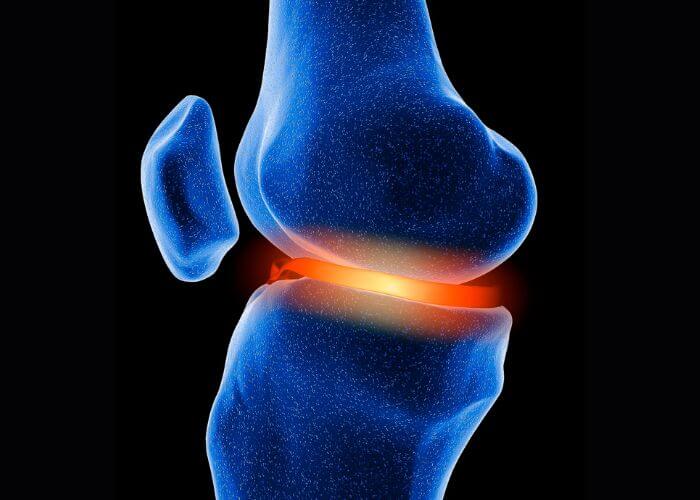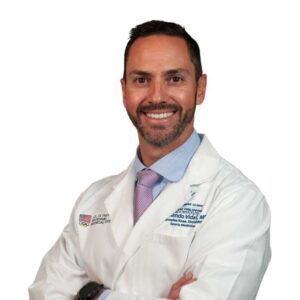What is Patella Chondromalacia?
Chondromalacia, also called “runner’s knee” is a condition where the articular cartilage underneath the knee cap (patella) softens and breaks down. The cartilage loses its ability to protect the ends of the bones as the joint moves, allowing the bones to rub against each other and cause pain, crepitus (crunchiness) and/or swelling. Chondromalacia is common among young athletes but can also occur in older adults who have arthritis of the knee. Dr. Armando Vidal, orthopedic knee specialist can successfully treat patients in Vail, Aspen and the surrounding Denver, Colorado communities who have knee pain and other chondromalacia symptoms.

What causes chondromalacia?
Sometimes called patellofemoral chondromalacia or chondromalacia patellae, the condition is caused when the underside of the patella (kneecap) rubs against the femur (thighbone) unevenly. In a “normal” knee, the patella sits on the top of the knee joint, gliding over cartilage of the femur when the knee bends. The tendons and ligaments attach the kneecap to the shinbone and thigh muscle. If any of these components move unevenly or improperly, deterioration in the cartilage of the patella can occur, resulting in chondromalacia. Causes of improper patella movement can occur from:
- Poor knee alignment – may be from a congenital condition
- Muscle imbalance – some muscles around the knee may be stronger than others
- Trauma – especially a break or dislocation
- Overuse – usually seen in sports that require the same knee movement
- Osteoarthritis or rheumatoid arthritis
- Injury to the meniscus
- Knee infection
- Repeated injection of steroids into the knee joint
- Malalignment of the muscles or bones
What are the symptoms of runner’s knee?
Knee pain, especially in the front, under the kneecap is the most common symptom of chondromalacia. This dull, aching pain can get worse with stair climbing or after sitting for a long period of time. Runner’s knee can also cause a grinding or catching sensation and sometimes the knee can swell or appear “puffy.”
How is chondromalacia diagnosed?
Dr. Vidal will obtain a thorough patient history, including prior injuries as well as daily activities and sporting event participation. A good physical exam of the affected knee along with radiographs and possibly an MRI will help Dr. Vidal with the diagnosis.
How is runner’s knee treated?
The mainstay of treatment for patella chondromalacia is non-operative management. For patients in Vail, Aspen and the surrounding Denver, Colorado communities, Dr. Vidal recommends a conservative approach when treating chondromalacia. His goal is to optimize your knee biomechanically and biologically as well as manage your load before considering surgical intervention. Biologic and biomechanical optimization can include:
- RICE (rest, ice, compression, elevation)
- Anti-inflammatory medication can help reduce swelling around the joint
- Physical Therapy – Probably the most important part of non-surgical treatment, physical therapy can strengthen the muscles, especially the hip muscle to take some of the stress off the kneecap.
- Bracing – The use of a stabilizing knee brace is effective for helping the knee to move correctly.
- Non-steroidal anti-inflammatory injections – Indicated in some cases to reduce swelling of the joint.
- Biologic injections (PRP/Stem Cell)
Surgical Treatment:
Surgical treatment for patella chondromalacia is only reserved for patients who have failed non-operative management or have mechanical symptoms so severe that they are unable to progress with PT.
Surgical decision making requires a comprehensive assessment of the contributing factors. Surgery can range from a simple arthroscopic procedure called a chondroplasty where the rough surfaces are simply smoothed out – to more complex realignment and cartilage restoration procedures.
Patella Chondromalacia Specialist
Are you an athlete experiencing knee pain after running, climbing stairs, or sitting down? If so, you may be experiencing Patella Chondromalacia, or runner’s knee. Runner’s knee is a condition where the cartilage of the knee wears down or becomes damaged, causing pain with movement. Patients in Vail, Aspen, and the surrounding Denver, Colorado communities experiencing knee pain should see Doctor Armando Vidal, a knee specialist and surgeon. Contact Dr. Vidal’s team today!

Locations
180 S Frontage Rd W
Vail, CO 81657
226 Lusher Court
Ste 101
Frisco, CO 80443
322 Beard Creek Road
Edwards, CO 81632


